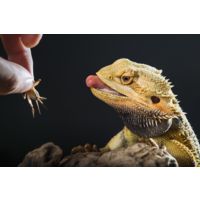Has anyone tried the latest fad, the paleo diet? I tried recently to lose a few kilos and our family gave the caveman diet a go. Although the kids, complained about missing junk food, we have never eaten better. It was during this time that I realized that we were eating just like our dragon lizards should….
We are lucky in Australia that we not only get to observe native “Beardies” relatively commonly in the wild, but domestic animals are also cheap and easy to keep as pets.
“Beardeds” are awesome pets which are growing in popularity all around the world. Their docile and bonding nature is attractive to all ages. In some circles, they are considered the best pet for kids due to their curious and social personalities. Two important considerations to ensure a long life for your pet are type of bearded dragon habitat and diet.
.png)
Wild Bearded Dragon, Brisbane, QLD
Juvenile Bearded Dragons should be kept in a terrarium habitat of at least 20 litres and double that for adult Bearded Dragon enclosure. Loose substrate is not recommended as part of a bearded dragon setup as digestive problems can result.
A heat lamp and heat pad are desirable for indoor pets and you may see them basking with their mouths open to allow their body temperature to cool down. This is similar to a dog panting.
Have you ever asked yourself ‘what do bearded dragons eat?’ This reptile is an omnivore meaning that it needs to eat both animals and plants….. same as people on a Paleo diet..
When young, they eat 80% bugs and 20% plants. However, as they age, the feeding ratio reverses to 80% plants and 20% insects & meat. Beardies are definitely not picky eaters and should be fed variety. In the right conditions and temperature, they will eat like vacuum cleaners.
The best animal based bearded dragon pet food is:
Insects:
- Crickets have long been the most popular live food, the lizards loving chasing them and eating them with gusto.
- Woodroaches (or Woodies) are clean insects that are highly nutritious and easily digestible due to their soft exoskeleton.
-
Black Soldier Fly Larvae (BSFL) or Vitaworms are growing in popularity. They have many benefits including a great calcium to phosphorous ratio which is great for your pets bones, eggs and young dragons. They also tempt the fussiest
-
Super worms are recommended for large bearded dragons.
- Mealworms are popular but should only be fed as a treat as too many (more than a few a day) can be difficult to digest and cause serious problems.
The insects should be fed “Gutload” powder prior to feeding and then sprinkled with Calcium and Multi-Vitamin Powders to improve their nutritional value.

All insects come in multiple sized insects and packages, from handy tubs to bulk and are avialabel on line with the powders from PetWave.
Baby dragon’s food should start at pinhead and extra small sizes, working up sizes as your dragon grows. Adult bearded dragon’s will easily eat large sized insects.
Rodents: A commonly asked question is should I feed my pet dragon meat? Well raw and processed meat such as mince or ham is out due to the risk of intestinal worms or preservatives. However, many lizard keepers are aware that mice can be an excellent food source for Bearded Dragons. Pinkie mice are very lean with less than 5% fat, increasing to 14% for larger fuzzy mice.
You can feed your adult bearded dragon mice on a regular basis (a few times a month). They can be ordered online in multiple pack sizes including bulk and stored in your freezer.
The best fruit and vegetables for your pet bearded dragon includes:
Collard greens (cabbage, water cress and broccoli leaves): are great stables consisting of nutrients, as well as vitamin C and immune system boosters. The leaves should be torn into small pieces and fed in a clean bowl in your bearded dragon tank.
Dandelion greens: feed the leaves not the flower to your bearded dragon. It consists of vitamins A, C and K. it is also a good source of calcium. Should be about 60% of plant diet.
Squash, Carrots & Sweet Potato: consists of beta carotene, antioxidants and minerals. Feed your lizard mash carrot so easy to digest. Should be about 15% of plant diet.
Snap Peas, Snow Peas & Alfalfa Sprouts: consists of vitamins and minerals. They are not easily swallowed by bearded dragon so chop them into small pieces. Should be about 15% of plant diet.
Figs, Papaya, Mango, Melons, Strawberries, Peaches: Excellent source of vitamins (including C).
Blueberries: This is a good source of antioxidants and vitamin K. Cut blueberries into half before your lizard feeds on it, to aid easy digestion.
Should be about 10% plant diet. Wash all fruits and vegetables properly before allowing your lizards to feed on them to avoid any dangerous pesticides.

Wild Bearded Dragon, Sunshine Coast, QLD
Bearded Dragon Care - Foods To Avoid: Raw and processed meat, fruit seeds, avacado, eggplant, rhubarb, many garden plants. Just like the Paleo diet, endeavor to always feed your lizards whole food items such as plants, insects and mice.
Next time you’re tempted by a “Bearded Dragon For Sale” sign, PetWave can help supply your new pet with premium live insects and frozen rodents. They will be delivered to your door right across Australia. Go to www.petwave.com.au to check out our range.

